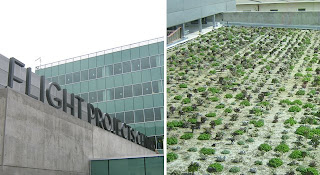 When residents of the top floors of JPL's new Flight Projects Center look out their windows down to the roof of the building's auditorium, they won't see black tar. Instead, they'll witness what looks more like Joshua Tree, Calif. -- desert, drought-resistant plants dotting sandy ground.
When residents of the top floors of JPL's new Flight Projects Center look out their windows down to the roof of the building's auditorium, they won't see black tar. Instead, they'll witness what looks more like Joshua Tree, Calif. -- desert, drought-resistant plants dotting sandy ground.The plants do more than enhance the view; they are part of the building's many "green" features. In fact, the building is so green that JPL is going for the gold -- a gold certification, that is, under the Leadership in Energy and Environmental Design rating system, set up by the non-profit U.S. Green Building Council.
The six-story Flight Projects Center will house missions in the busy design and development phases, when engineers and scientists from all around the world must work together closely. The first tenants are expected to move in this September.
To achieve a gold-level certification, the building must meet certain criteria. In general, it must consume water, energy and resources efficiently; treat the environment in friendly ways; and create a healthy and comfortable indoor workspace. Some of the building's green assets are listed here:
• A green, living roof will keep the building cool in the summer and warm in the winter. The green roof will also help minimize storm water runoff into the Arroyo Seco, a dry riverbed near JPL.
• Outdoor lights will be used solely for safety purposes. The lights are directed toward the ground, reducing the amount of light pollution that escapes to the night sky.
• Desert plants on the roof and the rest of the landscape will require 72 percent less water than a typical landscape design in Southern California.
• Low-flow faucets and toilets will reduce water use by 40 percent compared with typical fixtures. The building will save an estimated 500,000 gallons of water every year.
• Improved wall insulation, efficient chillers and boilers, window shading devices and the green roof will greatly reduce energy needs.
• More than 75 percent of the waste generated during construction was diverted from a landfill to a local recycling facility. Wood was acquired from Forest Stewardship Council certified suppliers, ensuring sustainable harvesting of trees.
• The paints and other surface materials have low levels of undesirable, toxic fumes.
• The heating and cooling system is "smart" -- it knows whether people are in a room and adjusts the temperature and ventilation accordingly.
• The janitorial staff will use green cleaning products and practices.
• Showers and bike racks will encourage people to leave their cars at home, and bike or walk to work.
More information about the Leadership in Energy and Environmental Design rating system and the U.S. Green Building Council is online at http://www.usgbc.org .


















0 comments:
Post a Comment